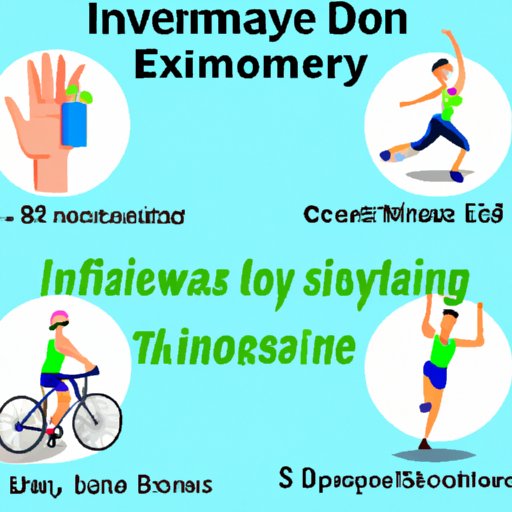I. Introduction
Inflammation is a natural response of the immune system to injury and infection. While it plays an essential role in repairing tissue damage and fighting off pathogens, chronic inflammation can lead to a host of health problems, from obesity, diabetes, and heart disease to autoimmune disorders and cancer.
Fortunately, there are several ways to help prevent and manage inflammation, one of which is regular exercise. Studies have shown that physical activity can be an effective strategy for reducing inflammation levels in the body and promoting long-term health benefits, from disease prevention to improved cognitive function and better overall wellbeing. In this article, we’ll explore the science behind how exercise helps fight inflammation, the ways in which regular physical activity can reduce inflammation in the body, and practical tips on incorporating exercise into your lifestyle to manage inflammation and improve your health.
II. The Science Behind How Exercise Fights Inflammation
Research has revealed that exercise exerts a powerful anti-inflammatory effect on the body, influencing the immune system and providing a natural defense against chronic inflammation. The mechanisms that underlie this response are complex and multifaceted, but they generally involve the following:
- Reducing pro-inflammatory cytokines: Cytokines are small proteins that are involved in immune responses that promote inflammation. When pro-inflammatory cytokines are overproduced, they can lead to chronic inflammation, tissue damage, and eventually, disease. Exercise has been shown to reduce pro-inflammatory cytokines, lowering inflammation levels in the body.
- Activating anti-inflammatory cytokines: Anti-inflammatory cytokines are the body’s natural way of fighting inflammation. Exercise has been shown to stimulate the production of these powerful immune system molecules, which can help counteract the effects of pro-inflammatory cytokines and reduce inflammation.
- Reducing oxidative stress: Oxidative stress is a condition where there are more free radicals in the body than antioxidant defenses. Free radicals are unstable molecules that can cause damage to cells, proteins, and DNA, leading to inflammation and disease. Exercise has been shown to reduce oxidative stress, lowering inflammation levels in the body.
- Increasing muscle mass: One of the many benefits of regular exercise is an increase in muscle mass, which can help reduce inflammation. Muscles are a significant source of cytokines that play both pro-inflammatory and anti-inflammatory roles. When muscles release anti-inflammatory cytokines, they can help reduce inflammation levels in the body.

III. 5 Ways Exercise Can Help Reduce Inflammation in the Body
Exercise has been shown to have a significant impact on inflammation levels in the body. Here are five ways exercise can help reduce inflammation:
- Increase physical activity: All types of physical activity, from moderate-intensity aerobic exercise to resistance training and high-intensity interval training, can help reduce inflammation. Being physically active for at least 30 minutes per day is recommended to achieve health benefits.
- Maintain a healthy weight: Obesity is a significant cause of chronic inflammation. Exercise can help maintain a healthy weight, reducing inflammation levels in the body.
- Reduce stress: Stress is another significant contributor to chronic inflammation. Exercise can help reduce stress levels, lowering inflammation in the body.
- Get enough sleep: Sleep deprivation can cause elevated inflammation levels in the body. Exercise can improve sleep quality and duration, reducing inflammation.
- Eat a healthy diet: A diet high in sugar, unhealthy fats, and refined carbohydrates can cause inflammation. Exercise combined with a healthy diet can significantly reduce inflammation in the body.
IV. Why Exercise Is the Best Natural Anti-Inflammatory
While there are many traditional approaches to inflammation management, such as medications, exercise is undoubtedly the best natural anti-inflammatory. Unlike medications, which come with a host of side effects and can be expensive, exercise is generally safe, cost-effective, and has numerous other health benefits. Regular exercise can help reduce the risk of chronic diseases, improve mental health, boost cognitive function, and help maintain a healthy weight.
V. Exercising Your Way to Less Inflammation: A Comprehensive Guide
Managing inflammation through exercise does not require a complete overhaul of your current lifestyle. Rather, it is about incorporating physical activity gradually. Here’s a comprehensive guide to help you manage inflammation through exercise:
- Start Small: Begin with a few minutes of physical activity daily and gradually increase it until you are exercising the recommended 30 minutes each day.
- Mix It Up: Incorporate different types of physical activities into your routine like running, swimming, weightlifting, and yoga, ensuring that you are getting a range of health benefits.
- Monitor Progress: Track your physical activity levels and inflammation levels, as well as other health and well-being measures to understand the effects of exercise on inflammation management and overall health.
- Stay Motivated: Find a workout partner, invest in a personal trainer, or find an exercise community to support you in your fitness journey.
- Make It a Habit: Keep to a regular routine and incorporate physical activity into your daily life, making it a habit and reducing inflammation in the body.
VI. The Link Between Exercise and Inflammation: What You Need to Know
A significant body of scientific research supports the link between exercise and the reduction of chronic inflammation. Researchers have shown that moderate-intensity aerobic exercise, resistance training, and high-intensity interval training can all reduce inflammatory markers. Regular exercise can help manage inflammation and reduce the risk of chronic diseases, including heart disease, diabetes, and some cancers.
VII. The Benefits of Exercise on Chronic Inflammation and Disease Prevention
Regular physical activity has several long-term health benefits, including reducing the risk of chronic inflammation, disease prevention, and improved overall health. Studies have shown that people who engage in regular exercise have a lower risk of heart disease, cancer, and diabetes. Exercise can also improve insulin sensitivity, cognitive function, and bone density.
VIII. How Different Types of Exercise Affect Inflammation and Your Health
Different types of exercises affect inflammation levels and have different benefits for your health. Aerobic exercise helps counteract inflammation and reduce the risk of chronic disease, while resistance training builds muscle and aids weight management, both of which help reduce inflammation. Yoga and other low-impact activities can help reduce stress levels and improve flexibility and balance.
IX. Conclusion
Inflammation is a natural process in the body, but when it becomes chronic, it can cause a range of health problems, from obesity and diabetes to autoimmune disorders and cancer. Regular exercise is a powerful tool in managing chronic inflammation, reducing the risk of chronic disease, improving overall health, and boosting cognitive function. By incorporating physical activity into your daily routine and maintaining a healthy lifestyle, you can help fight chronic inflammation and achieve optimal well-being.
(Note: Is this article not meeting your expectations? Do you have knowledge or insights to share? Unlock new opportunities and expand your reach by joining our authors team. Click Registration to join us and share your expertise with our readers.)
